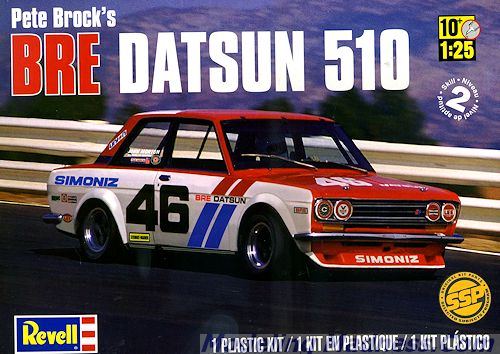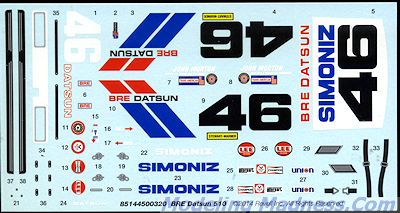
Revell 1/25 BRE Datsun 510
| KIT #: | 1445 |
| PRICE: | $24.95 |
| DECALS: | One option |
| REVIEWER: | Scott Van Aken |
| NOTES: | 2014 Reissue |

| HISTORY |
The Datsun 510 was a series of the Datsun Bluebird sold from 1968 to 1973, and offered outside the U.S. and Canada as the Datsun 1600. According to AutoWeek's G.D. Levy, the 510 has often been called the "poor man's BMW." The 510's engineering was inspired by contemporary European sedans, particularly the 1966 BMW 1600-2, incorporating a SOHC engine, MacPherson strut suspension in front and independent, semi-trailing arms in the back. The European-influenced sheet metal design is attributed to Datsun in-house designer, Teruo Uchino.
The engine was pushed through by Nissan USA president Yutaka Katayama, a design developed through Prince, an acquisition.
Launched in October 1967, it was one of the most comprehensive Bluebird ranges in terms of body styles: a two-door sedan (added in June 1968), a four-door sedan, a five-door station wagon, and a two-door coupé (added in November 1968).
This range became famous for Nissan's rallying successes outside Japan and paved the way for greater Nissan sales internationally.
The Datsun 510 released to the U.S. market came originally with the Hitachi downdraft carbureted 1.6L L-series I4 engine, with an advertised gross power of 96 hp (72 kW), a claimed top speed of 100 mph, front disc brakes, four-wheel independent suspension (MacPherson strut front and semi trailing arm rear- wagons had a solid rear live axle and leaf springs in back), rear-wheel drive, and either a four-speed manual or a three-speed automatic transmission. Two-door sedan, four-door sedan, and four-door station wagon variants were available. It achieved 20 to 30 mpg in factory trim (U.S.). JDM spec models were also available in a two-door coupe body style in either a 1.6L or a 1.8L (1973) L-Series engine. 510s, in some markets, offered twin Hitachi side-draft carburetors, which were a smaller version of the British SU (Skinner's Union) design used on Jaguars and MGs. These engines also used enhanced compression and camshaft profiles to produce more power. SSS models (not available for the U.S. 510) offered upgraded instrumentation and interior trim, as well as appropriate exterior badges. All U.S. model 510s received anti-sun glass from 1970 on.
The 510 was successfully campaigned by Brock Racing Enterprises in the under 2.5 liter Trans-Am series by Pete Brock and John Morton in 1971 and 1972 with John Morton winning the championship both years.
| THE KIT |
This is a reissue of a kit that first appeared in the 1970s in this version and has since been issued in a standard/customized boxing as well. Molded in white plastic, the 82 parts are still flash free and look to be just like the original. Personally, I do not like white plastic as it is too difficult to see any mold seams and such until after it has been primered, but that is the way most car kits are done.
The kit has a nicely done four cylinder engine and rather interestingly, comes with a section of tubing so that one can duplicate the water coolant and oil lines that run all over the engine compartment. A guide is provided so you can cut the tubing to the correct lengths.
As you'd expect from a racer the interior is pretty well gutted with only a seat for the driver. A roll cage is also part of the package. The single piece floor pan has side panels to add along with the stripped down dash. There are decals to add for the instruments.
One has a nicely done suspension that includes a
nicely detailed rear suspension piece. The front suspension is built up of
several pieces. I found it interesting that a racing car would have an exhaust
pipe, yet there it is. Racing tires are provided to go along with the racing
wheels. All of the glass pieces are
 separate and
designed to be installed from the outside, which will be a real help in
construction. There is plenty of chrome for some engine parts as well as the
grille and bumpers along with the wheels. One will want to paint the wheel
centers in a darker metal shade.
separate and
designed to be installed from the outside, which will be a real help in
construction. There is plenty of chrome for some engine parts as well as the
grille and bumpers along with the wheels. One will want to paint the wheel
centers in a darker metal shade.
Instructions are well done providing clearly drawn construction steps. Colors are generic and shown throughout the build. The set of decals is for John Morton's #46 car, which is basically red with white sides. The decals are very nicely done, though I'm not sure if the white bits will be able to stay white once placed on all that red.
| CONCLUSIONS |
It is nice to see this kit return to the shelves. Originals were getting stupid money on the auction sites and one hopes that the standard car will also be reissued. Thanks to two different licensing requirements; one with BRE and the other with Nissan, the kit is not inexpensive. I was discussing this with someone who knows something about licensing and it is estimated that licensing adds about $4-5 to each racing car kit. More if multiple licensing is required. One reason why you do not see new NASCAR kits. One other thing I noticed is that this kit has the flimsiest box I've ever seen in a Revell kit. If you are familiar with the thin, el cheapo cardboard used by Eastern European kits back in the 1980s, then that is what this seems like. I nearly punched holes in the box bottom with my fingers just trying to pry the top from this one.
| REFERENCES |
http://en.wikipedia.org/wiki/Datsun_510
July 2014 Thanks to me for picking
this one up. If you would like your product reviewed fairly and fairly quickly, please contact the editor or see other details in the
Note to
Contributors.